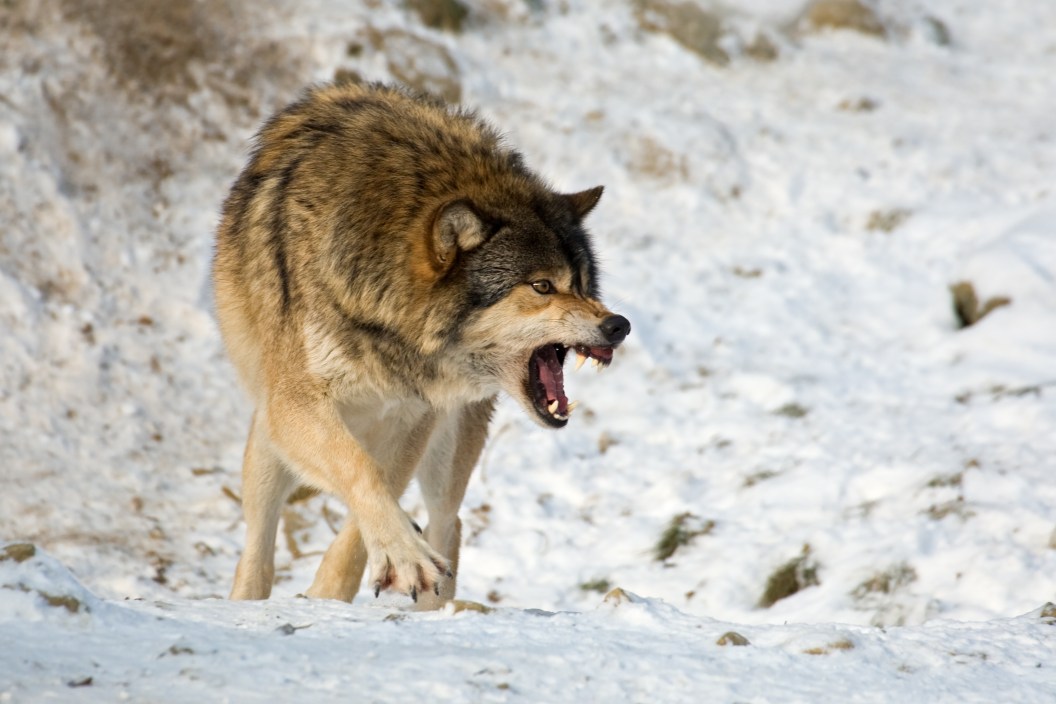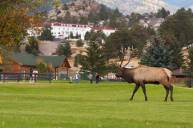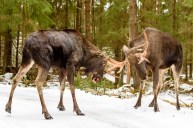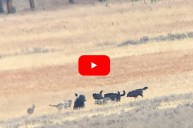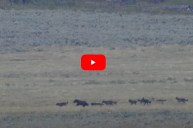National parks offer a unique experience for watching wildlife in their natural habitat and interacting with each other. It's exciting to watch cute bear cubs wrestling with each other on a river bank at Denali, or driving through Yellowstone and seeing bison walking on or alongside the road.
While it's tempting to snap a close-up picture for the 'gram, you must remember these are wild animals, and and an animal encounter can quickly dangerous or even deadly if you're not careful. The most dangerous animals at national parks range from apex predators to hoofed mammals, to some of the smallest but most deadly creatures the world has ever known.
If you don't know what to do if you come face to face with one, it could get ugly quickly. Here, the most dangerous animals to look out for and the best way to keep yourself—and them—safe.
Predator: Bears
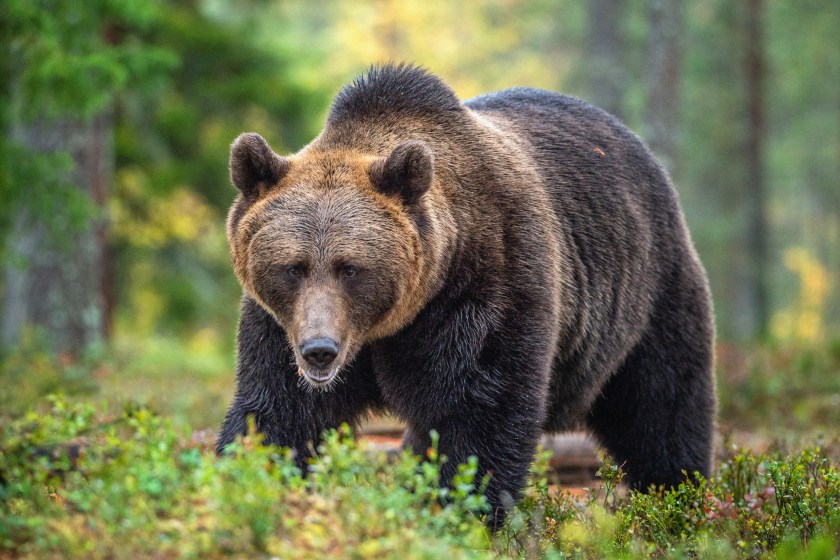
Getty Images, USO
Where you'll find them: Two types of bears inhabit our national parks: brown bears or grizzlies and black bears. Grizzly bears are a subspecies of brown bears and can be primarily found in northern states like Wyoming, Montana, Idaho, Washington, and Alaska in parks such as Yellowstone, Grand Teton, Glacier, Katmai, and Denali. Black bears can be found all across the mainland U.S., with higher concentrations in the southwest and southeast in parks such as Shenandoah and the Great Smoky Mountains.
Bears might be cute from the other side of a zoo enclosure, but they can also be ferocious and vicious creatures if encountered in the wild. As apex predators, these animals should be observed from a distance and given a wide berth if spotted; they can be unpredictable when it comes to their interactions with humans. Bears eat a wide variety of foods, ranging from nuts and berries to elk and trout, but some have become acclimated to human food—a.k.a. "food-conditioned"—which makes close encounters all the more more common.
While bear attacks in national parks are few and far between, they aren't nonexistent. According to the National Park Service, bear injuries in Yellowstone National Park average about one every 20 years, and total bear-caused fatalities are fewer than deaths caused by drowning, burns, and suicide. "To put it in perspective," the NPS explains, "the probability of being killed by a bear in the park (eight incidents) is only slightly higher than the probability of being killed by a falling tree (seven incidents), in an avalanche (six incidents), or being struck and killed by lightning (five incidents)."
How to stay safe: It's extremely important to always be prepared in case you encounter a bear. Before you start your adventure, check in with the park's visitor center for any updates on bear safety. Make sure you have a can of bear spray with you and know how to deploy it. And should you come face to face with one, stay calm especially if you're around a mother and her cubs. Avoid eye contact and back away slowly.
Predator: Wolves
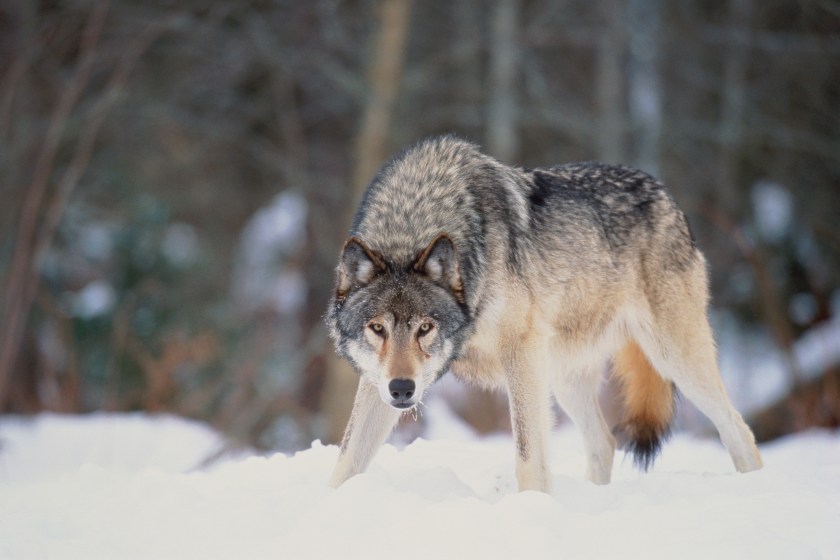
Getty Images, Art Wolfe
Where you'll find them: Wolves are primarily found in northern states such as Wyoming, Idaho, Montana, Michigan, Minnesota, and Alaska in parks such as Yellowstone, Grand Teton, Isle Royale, Voyageurs, Katmai, and Denali. But while wolves are larger than you think and dangerous to their prey, they rarely attack humans—the number of incidents is considered far too low to even calculate.
The reputation of wolves has gone back and forth between being admired and feared, and from being considered a pest to being federally protected by an endangered listing. As key players in conserving the environment and regulating ecosystems, wolves' diet varies between small and large prey. What makes them dangerous is that they can kill animals that other predators can't usually kill, such as elk, deer, and bison. And while coyotes can wait nearby to clean up the scraps, bears are some of the only other animals that can scare wolves away from their meals. But protecting livestock is ultimately what caused humans to hunt wolves almost to extinction, according to the NPS.
How to stay safe: Just like most predators, wolves can become dangerous to people if they become habituated towards human-related food including poorly handled camp food, garbage, and livestock. So if you're visiting popular wolf havens like Yellowstone, make sure you know what to do in case you encounter a wolf. It's similar to what you should do if you encounter a bear, except the difference is that you'll want to yell or throw stuff at the animal if it approaches you. Worst-case scenario, you can always deploy your can of bear spray. And if you bring your dog with you to go hiking or camping, make sure to keep it leashed.
Ungulate: Bison
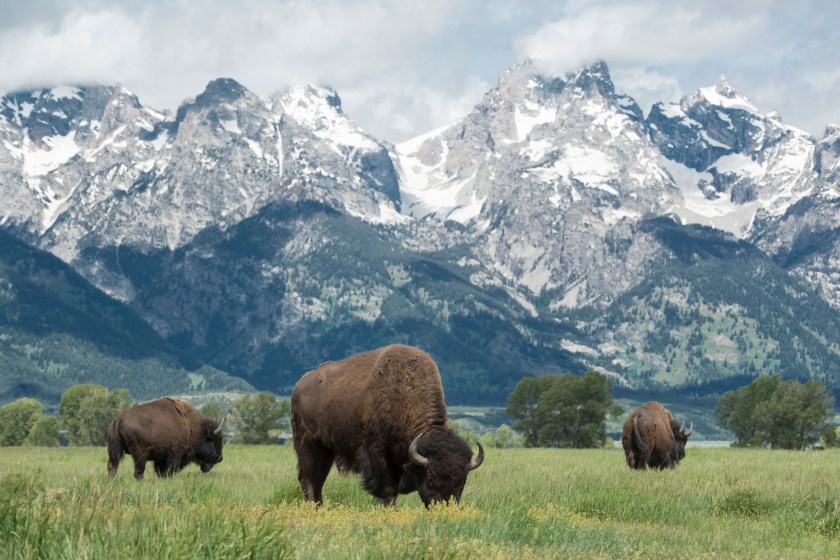
Getty Images, JohnnyGreig
Where you'll find them: The carnivorous predators with sharp teeth and claws aren't the only dangerous animals in national parks. Ungulates, a.k.a., hoofed mammals, such as bison, elk, and moose can be menacing, too. America's largest land mammal, bison were once considered endangered, but according to the NPS, bison populations have been recovering from less than 1,000 to 19 herds that roam across 12 states that make up the Great Plains. Parks such as Badlands, Grand Canyon, Grand Teton, Theodore Roosevelt, Wind Cave, Wrangell-St. Elias, and Yellowstone have partnered with Indigenous Tribes and Canadian First Nationals to actively advance conservation efforts.
Bison are large herbivores but are surprisingly agile and fast, able to run up to 40 miles per hour. In 2022 there were three incidents of bison attacking people in Yellowstone, but avoiding bison attacks isn't that hard. Most attacks are provoked by tourists failing to observe the bison responsibly, so trust us—the selfie isn't worth it.
How to stay safe: The NPS recommends that visitors stay at least 25 yards away from the creatures. Bison are incredibly protective of their families, so don't hike through bison herds, especially you observe a cow and a calf. If one stops and looks at you, that's a warning sign that you're too close. Slowly back away, and don't make any sudden movements to startle it more than your presence already has. Remember, the point is to prevent bison attacks because once one's charging at you, there's not much you can do about it.
Ungulate: Elk
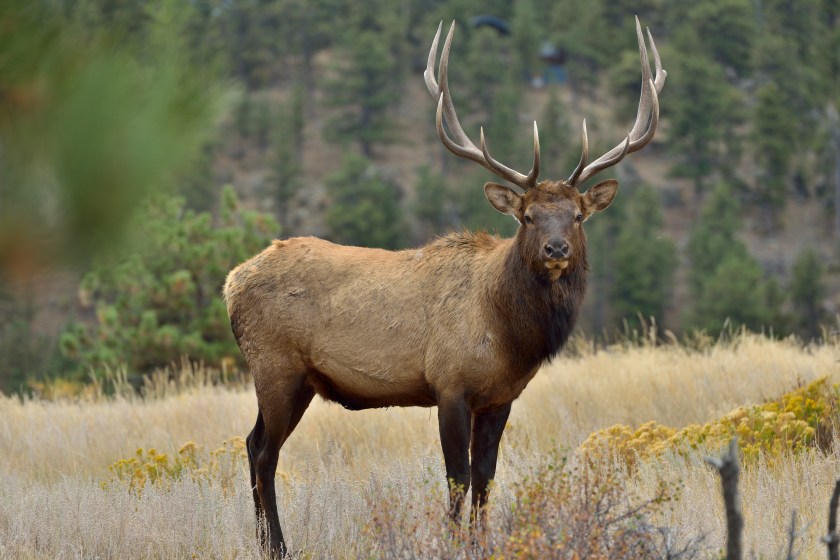
Getty Images, SeanXu
Where you'll find them: An estimated 1 million elk live in the United States, with 10,000 to 20,000 elk in Yellowstone National Park alone. They also reside in the Great Smoky Mountains National Park, Olympic National Park, Rocky Mountain National Park, and the south rim of the Grand Canyon.
Elk are larger than bears and can be dangerous despite being deer. And while they rarely attack humans, there is a consistent history of elk-related injuries. Unlike with most bison, elk may attack without provocation. So it's important to know when you should be extremely wary of elks and know what to do if one charges at you.
While you wouldn't automatically be in danger if you see one, it's important to keep your distance, especially during two specific times of the year. Cow elk are extremely protective of their young, so you'll want to avoid being in their line of sight during calving season which is late spring and early summer. You'll also want to keep your distance around mating season in September and October; bull elk are very aggressive when seeking mates, with their testosterone levels rising as they spar with each other for the mating rights of multiple cow elks.
How to stay safe: While keeping a 25-yard distance from an ungulate is the standard, it's recommended to add an extra five yards for elk. The signs of an elk that's agitated include teeth grinding, ears laying backward, lips curling, raised back hair, or pacing behavior of stopping and circling around.
If you notice these signs or realize you're too close to an elk, slowly back away while making sure you don't startle it. Unlike bison, if an elk starts charging at you, you can likely run and find cover to escape. According to the NPS, it's very unlikely for elk to follow you. If they do, it won't be very far. And if you get knocked down by one, curl up into the fetal position and protect your head with your arms while keeping still. Fighting back will only convince it that you're a threat.
Ungulate: Moose
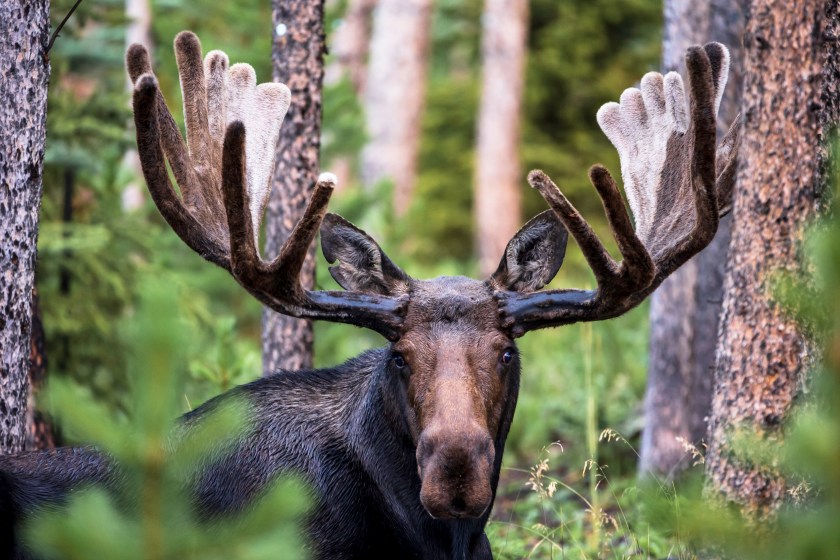
Getty Images, Wirestock
Where you'll find them: Moose are the largest members of the deer family. They're nearly a foot taller than elk and can weigh up to 1,500 pounds. In addition, moose are distinguishable from elk by their larger antlers. They can be found in northern states such as Michigan, Wyoming, Montana, Idaho, and Alaska. Some of the best national parks to see moose include Isle Royale, Yellowstone, Grand Teton, Glacier, Rocky Mountain, Denali, and Voyageurs.
How to stay safe: People are more likely to get injured by moose than bears. If you're perceived as a threat when encountering a moose, these animals won't hesitate to charge at you especially if a cow is with its calf. By law, national park visitors must stay at least 25 yards away. If you see one while adventuring, you really don't want to be noticed. If you are, you'll have to convince it that you're not a threat. That means talking in soft voices and slowly moving out of the area to create distance between you and the animal.
Take extra precaution if you notice signs that the moose is agitated such as laid-back ears and have upright hackles. Those signs mean that it's getting ready to charge at you. Thankfully, you can run away from moose the same way you can run away from elk if one starts charging at you.
Small But Dangerous: Black Widow Spiders
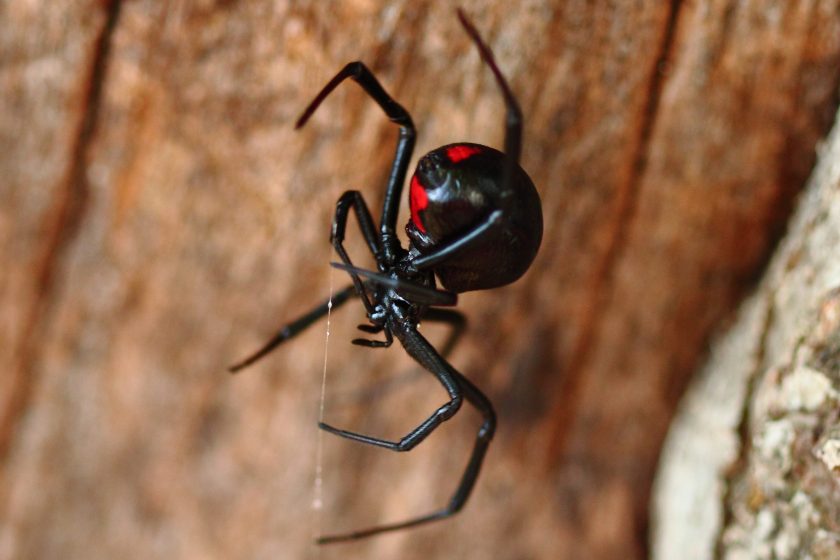
Getty Images, KAdams66
Where you'll find them: Some of the most dangerous animals in national parks aren't the biggest ones. Black widow spiders are the most venomous spiders in North America, about 15 times stronger than rattlesnake venom according to Smithsonian magazine. Identifiable by their black, globe-shaped abdomens with a red or orange hourglass right in the middle, black widows are found in the southern and western U.S. in parks such as Arches, Grand Canyon, Zion, White Sands, and Canyonlands National Parks.
About 2,200 people report getting bitten by a black widow every year. Of those, fewer than 10 people die, and those occur mostly because of compromised immune systems or a severe allergic reaction to the venom. Black widow bites are extremely painful and cause serious symptoms if not treated medically. According to Poison Control, black widow bite symptoms can vary and include stabbing pain, swelling, red spots from where the spider punctured the skin with its fangs, pain in the abdomen and back, nausea, profuse sweating, difficulty breathing, tremors, fever, and increased blood pressure.
How to stay safe: Like most animals, these spiders are not aggressive unless they're startled or defensive. However, you should be careful while hiking or camping through a national park. The NPS recommends that you avoid sticking your hands in places that you can't see like in leaves or under rocks. If you're gathering firewood, wear gloves to do so or while you're moving rocks or debris. And make sure to always shake out your clothing and shoes when changing. If you get bitten, seek medical attention immediately.
Small But Dangerous: Ticks
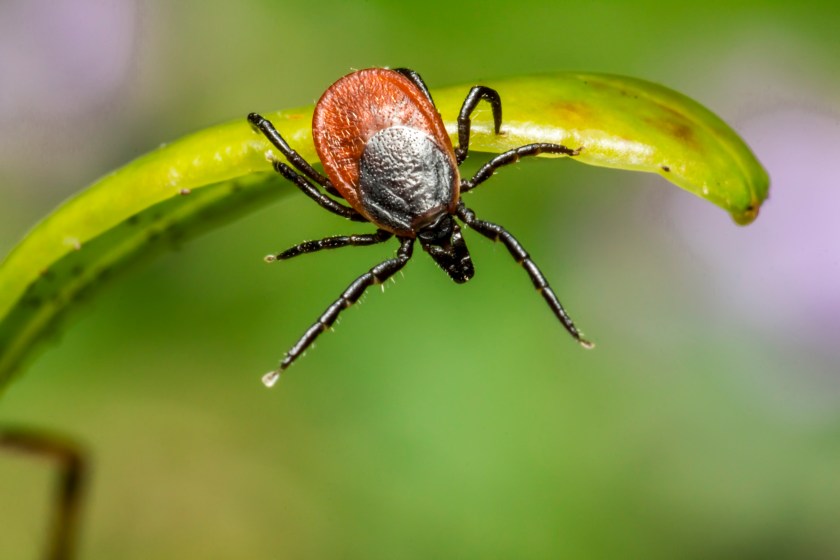
Getty Images, ErikKarits
Where you'll find them: Ticks are some of the most dangerous animals in national parks because they can cause diseases in humans and animals, but they are very difficult to see with the naked eye. Ticks are found all across the U.S. in mostly busy, wooded, and grassy areas so you might find them in pretty much any national park, including Rocky Mountain, Acadia, Cuyahoga Valley, Shenandoah, and Sequoia, and Kings Canyon National Parks.
Though deer ticks get most of the bad rap for transmitting Lyme disease, at least nine types of ticks are known to spread diseases, including Lyme, Rocky Mountain spotted fever, and Alpha-gal syndrome. Interestingly, ticks only require three blood meals to complete their life cycles.
How to stay safe: Prevention is the best way to protect yourself from ticks while exploring a national park. Hikers should always stay in the center of trails and avoid high grassy areas. Wear an insect repellant containing DEET or another ingredient that's EPA-registered as a tick deterrent, and spray it over your hiking boots, too. You can also treat your clothing and gear with permethrin.
Carefully inspect your body, clothing, and pets for ticks at the end of the day and the next morning, and tumble dry your clothes on high heat for an hour. Ticks can be found in places that are hard to see such as the underarm, scalp, and groin areas. If you find a tick, use fine-tipped tweezers to grasp it as close to your skin as you can. Pull it upwards evenly, carefully not twisting or jerking it. Once removed, you can dispose of it by putting it in alcohol, placing it in a sealed container, or flushing it down the toilet. Clean the bite area and your hands with rubbing alcohol or soap and water, and seek medical treatment if you suspect Lyme exposure.
General Safety Tips Around Dangerous Animals
We can't emphasize enough how important it is to know what to do when you encounter wildlife in a national park. For the bigger animals, you generally want to express that you are not a threat or prey by keeping them in your sight without making eye contact and backing away slowly. Most animals won't be aggressive towards you if you can convince them that you're not worth the effort.
A good way to gauge if you're too close to an animal is by using the Thumb Rule:
- Make a thumbs-up gesture towards the animal in front of you.
- Place your thumb on the animal in your point of view.
- If you can still see parts of the animal around your thumb, you're too close. Slowly back away to give the creature some space.
If you're unsure what to do, think calmly about the situation. If you see an animal with its babies, give it a very wide berth, as most mothers will become protectively aggressive of their young. Never run from an animal unless it's a moose or elk because that could startle it even more. And never leave any human food or garbage around. Dispose of waste properly so that an animal doesn't become habituated towards humans. Even if the habituated animal doesn't harm you, it could harm the next human that crosses its path.
READ MORE: 9 Best National Parks for Outdoor Enthusiasts
